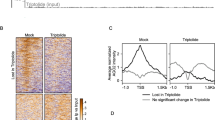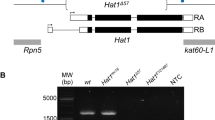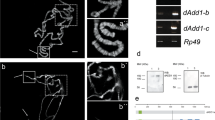Abstract
Phosphorylation of the large RNA Polymerase II subunit C-terminal domain (CTD) is believed to be important in promoter clearance and for recruiting protein factors that function in messenger RNA synthesis and processing. P-TEFb is a protein kinase that targets the (CTD). The goal of this study was to identify chromatin modifications and associations that require P-TEFb activity in vivo. We knocked down the catalytic subunit of P-TEFb, Cdk9, in Drosophila melanogaster using RNA interference. Cdk9 knockdown flies die during metamorphosis. Phosphorylation at serine 2 and serine 5 of the CTD heptad repeat were both dramatically reduced in knockdown larvae. Hsp 70 mRNA induction by heat shock was attenuated in Cdk9 knockdown larvae. Both mono- and trimethylation of histone H3 at lysine 4 were dramatically reduced, suggesting a link between CTD phosphorylation and histone methylation in transcribed chromatin in vivo. Levels of the chromo helicase protein CHD1 were reduced in Cdk9 knockdown chromosomes, suggesting that CHD1 is targeted to chromosomes through P-TEFb-dependent histone methylation. Dimethylation of histone H3 at lysine 36 was significantly reduced in knockdown larvae, implicating CTD phosphorylation in the regulation of this chromatin modification. Binding of the RNA Polymerase II elongation factor ELL was reduced in knockdown chromosomes, suggesting that ELL is recruited to active polymerase via CTD phosphorylation.











Similar content being viewed by others
References
Adhvaryu KK, Morris SA, Strahl BD, Selker EU (2005) Methylation of histone H3 Lysine 36 is required for normal development in Neurospora crassa. Eukaryotic Cell 4:1455–1464
Ahn SH, Kim M, Buratowski S (2004) Phosphorylation of serine 2 within the RNA Polymerase II C-terminal domain couples transcription and 3′ end processing. Mol Cell 13:67–76
Andrulis ED, Guzman E, Doring P, Werner J, Lis JT (2000) High-resolution localization of Drosophila Spt5 and Spt6 at heat shock genes in vivo roles in promoter proximal pausing and transcription elongation. Genes Dev 14:2635–2649
Beisel C, Imhof A, Greene J, Kremmer E, Sauer F (2002) Histone methylation by the Drosophila epigenetic transcriptional regulator Ash1. Nature 419:857–862
Bettencourt-Dias M, Giet R, Sinka R, Mazumdar A, Lock WG, Balloux F, Zafiropoulos PJ, Yamaguchi S, Winter S, Carthew RW, Cooper M, Jones D, Frenz L, Glover DM (2004) Genome-wide survey of protein kinases required for cell cycle progression. Nature 432:980–987
Byrd KN, Shearn A (2003) ASH1, a Drosophila trithorax group protein, is required for methylation of lysine 4 residues on histone H3. Proc Natl Acad Sci USA 100:11535–11540
Chao SH, Price DH (2001) Flavopiridol inactivates P-TEFb and blocks most RNA polymerase II transcription in vivo. J Biol Chem 276:31793–31799
Chao SH, Fujinaga K, Marion JE, Taube R, Sausville EA, Senderowicz AM, Peterlin BM, Price DH (2000) Flavopiridol inhibits P-TEFb and blocks HIV-1 replication. J Biol Chem 275:28345–28348
Eissenberg JC, Ma J, Gerber MA, Christensen AC, Kennison JA, Shilatifard A (2002) dELL, an essential RNA polymerase II elongation factor with a general role in development. Proc Natl Acad Sci USA 99:9894–9899
Eissenberg JC, Khorasanizadeh S (2005) Chromo and chromo shadow domains. In: Cesareni G, Gimona M, Sudol M, Yaffe M (eds) Structure and function of modular protein domains. Wiley VCH, Weinheim, pp 241–255
Flanagan JF, Mi L-Z, Chruszcz M, Cymborowski M, Clines KL, Kim Y, Minor W, Rastinejad F, Khorasanizadeh S (2005) Double chromodomains cooperate to recognize the methylated histone H3 tail. Nature 438:1181–1185
Garber ME, Mayall TP, Suess EM, Meisenhelder J, Thompson NE, Jones KA (2000) CDK9 autophosphorylation regulates high-affinity binding of the human immunodeficiency virus type 1 tat-P-TEFb complex to TAR RNA. Mol Cell Biol 20:6958–6969
Gerber M, Shilatifard A (2003) Transcriptional elongation by RNA polymerase II and histone methylation. J Biol Chem 278:26303–26306
Gerber M, Eissenberg JC, Kong S, Tenney K, Conaway JW, Conaway RC, Shilatifard A (2004) In vivo requirement of the RNA polymerase II elongation factor Elongin A for proper gene expression and development. Mol Cell Biol 24:9911–9919
Gerber M, Ma J, Dean K, Eissenberg JC, Shilatifard A (2001) Drosophila ELL is associated with actively elongating RNA polymerase II on transcriptionally active sites in vivo. EMBO J 20:6104–6114
Gerber MA, Shilatifard A, Eissenberg JC (2005) Mutational analysis of an RNA Polymerase II elongation factor in Drosophila melanogaster. Mol Cell Biol 25:7803–7811
Giordano E, Rendina R, Peluso I, Furia M (2002) RNAi triggered by symmetrically transcribed transgenes in Drosophila melanogaster. Genetics 160:637–648
Gong WJ, Golic KG (2006) Loss of Hsp70 in Drosophila is pleiotropic, with effects on thermotolerance, recovery from heat shock and neurodegeneration. Genetics 172:275–286
Hampsey M, Reinberg D (2003) Tails of intrigue: phosphorylation of RNA polymerase II mediates histone methylation. Cell 113:429–432
Hartzog GA, Wada T, Handa H, Winston F (1998) Evidence that Spt4, Spt5, and Spt6 control transcription elongation by RNA polymerase II in Saccharomyces cerevisiae. Gene Dev 12:357–369
Ivanov D, Kwak YT, Guo J, Gaynor RB (2000) Domains in the SPT5 protein that modulate its transcriptional regulatory properties. Mol Cell Biol 20:2970–2983
Jennings BH, Shah S, Yamaguchi Y, Seki M, Phillips RG, Handa H, Ish-Horowicz D (2004) Locus-specific requirements for Spt5 in transcriptional activation and repression in Drosophila. Curr Biol 14:1680–1684
Jones JC, Phatnani HP, Haystead TA, MacDonald JA, Alam SM, Greenleaf AL (2004) C-terminal repeat domain kinase I phosphorylates Ser2 and Ser5 of RNA polymerase II C-terminal domain repeats. J Biol Chem 279:24957–24964
Kaplan CD, Morris JR, Wu C-T, Winston F (2000) Spt5 and Spt6 are associated with active transcription and have characteristics of general elongation factors in D. melanogaster. Genes Dev 12:2623–2634
Keegan BR, Feldman JL, Lee DH, Koos DS, Ho RK, Stainier DY, Yelon D (2002) The elongation factors Pandora/Spt6 and Foggy/Spt5 promote transcription in the zebrafish embryo. Development 129:1623–1632
Kelley DE, Stokes DG, Perry RP (1999) CHD1 interacts with SSRP1 and depends on both its chromodomain and its ATPase/helicase-like domain for proper association with chromatin. Chromosoma 108:10–25
Keogh M-C, Podolny V, Buratowski S (2003) Bur1 kinase is required for efficient transcription elongation by RNA polymerase II. Mol Cell Biol 23:7005–7018
Kiger AA, Baum B, Jones S, Jones MR, Coulson A, Echeverri C, Perrimon N (2003) A functional genomic analysis of cell morphology using RNA interference. J Biology 2:27
Komarnitsky P, Cho EJ, Buratowski S (2000) Different phosphorylated forms of RNA polymerase II and associated mRNA processing factors during transcription. Genes Dev 14:2452–2460
Krogan NJ, Kim M, Tong A, Golshani A, Cagney G, Canadien V, Richards DP, Beattie BK, Emili A, Boone C, Shilatifard A, Buratowski S, Greenblatt J (2003) Methylation of histone H3 by Set2 in Saccharomyces cerevisiae is linked to transcriptional elongation by RNA polymerase II. Mol Cell Biol 23:4207–4218
Lachner M, Sengupta R, Schotta G, Jenuwein T (2004) Trilogies of histone lysine methylation as epigenetic landmarks of the eukaryotic genome. Cold Spring Harbor Symp Quant Biol 69:209–218
Lee JM, Greenleaf AL (1991) CTD kinase large subunit is encoded by CTK1, a gene required for normal growth of Saccharomyces cerevisiae. Gene Expr 1:149–167
Lee JM, Greenleaf AL (1997) Modulation of RNA polymerase II elongation efficiency by C-terminal heptapeptide repeat domain kinase I. J Biol Chem 272:10990–10993
Li J, Moazed D, Gygi SP (2002) Association of the histone methyltransferase Set2 with RNA polymerase II plays a role in transcription elongation. J Biol Chem 277:49383–49388
Li B, Howe L, Anderson S, Yates JR 3rd, Workman JL (2003) The Set2 histone methyltransferase functions through the phosphorylated carboxyl-terminal domain of RNA polymerase II. J Biol Chem 278:8897–8903
Licatalosi DD, Geiger G, Minet M, Schroeder S, Cilli K, McNeil JB, Bentley DL (2002) Functional interaction of yeast pre-mRNA 3′ end processing factors with RNA polymerase II. Mol Cell 9:1101–1111
Lindstrom DL, Hartzog GA (2001) Genetic interactions of Spt4-Spt5 and TFIIS with the RNA polymerase II CTD and CTD modifying enzymes in Saccharomyces cerevisiae. Genetics 159:487–497
Lindstrom DL, Squazzo SL, Muster N, Burckin TA, Wachter KC, Emigh CA, McCleery JA, Yates JR 3rd, Hartzog GA (2003) Dual roles for Spt5 in pre-mRNA processing and transcription elongation revealed by identification of Spt5-associated proteins. Mol Cell Biol 23:1368–1378
Lis JT, Wu C (1993) Protein traffic on the heat shock promoter: parking, stalling, and trucking along. Cell 74:1–4
Lis JT, Mason P, Peng J, Price DH, Werner J (2000) P-TEFb kinase recruitment and function at heat shock loci. Genes Dev 14:792–803
Liu CL, Kaplan T, Kim M, Buratowski S, Schreiber SL, Friedman N, Rando OJ (2005) Single-nucleosome mapping of histone modifications in S. cerevisiae. PLoS Biol 3:1753–1769
Marshall NF, Price DH (1995) Purification of P-TEFb, a transcription factor required for the transition into productive elongation. J Biol Chem 270:12335–12338
Marshall NF, Peng J, Xie Z, Price DH (1996) Control RNA polymerase II elongation potential by a novel carboxyl-terminal domain kinase. J Biol Chem 271:27276–27283
McCracken S, Fong N, Yankulov K, Ballantyne S, Pan G, Greenblatt J, Patterson SD, Wickens M, Bentley DL (1997) The C-terminal domain of RNA polymerase II couples mRNA processing to transcription. Nature 385:357–361
Morris SA, Shibata Y, Noma K-I, Tsukamoto Y, Warren E, Temple B, Grewal SIS Strahl BD (2005) Histone H3 K36 methylation is associated with transcription elongation in Schizosaccharomyces pombe. Eukaryotic Cell 4:1446–1454
Murray S, Udupa R, Yao S, Hartzog G, Prelich G (2001) Phosphorylation of the RNA Polymerase II carboxy-terminal domain by the Bur1 cyclin-dependent kinase. Mol Cell Biol 21:4089–4096
Napolitano G, Majello B, Licciardo P, Giordano A, Lania L (2000) Transcriptional activity of positive transcription elongation factor b kinase in vivo requires the C-terminal domain of RNA polymerase II. Gene 254:139–145
Ni Z, Schwartz BE, Werner J, Suarez R-R, Lis JT (2004) Coordination of transcription, RNA processing, and surveillance by P-TEFb kinase on heat shock genes. Mol Cell 13:55–65
Nybakken K, Vokes SA, Lin T-Y, McMahon AP, Perrimon N (2005) A genome-wide RNA interference screen in Drosophila melanogaster cells for new components of the Hh signaling pathway. Nat Genet 37:1323–1332
Pray-Grant MG, Daniel JA, Schieltz D, Yates JR III Grant PA (2005) Chd1 chromodomain links histone H3 methylation with SAGA- and SLIK-dependent acetylation. Nature 433:434–438
Price DH (2000) P-TEFb, a cyclin-dependent kinase controlling elongation by RNA polymerase II. Mol Cell Biol 20:2629–2634
Proudfoot NJ, Furger A, Dye MJ (2002) Integrating mRNA processing with transcription. Cell 108:501–512
Ramanathan Y, Rajpara SM, Reza SM, Lees E, Shuman S, Mathews MB, Pe’ery T (2001) Three RNA polymerase II carboxyl-terminal domain kinases display distinct substrate preferences. J Biol Chem 276:10913–10920
Schaft D, Roguev A, Kotovic KM, Shevchenko A, Sarov M, Shevchenko A, Neugebauer KM, Stewart AF (2003) The histone 3 lysine 36 methyltransferase, SET2, is involved in transcriptional elongation. Nucl Acids Res 31:2475–2482
Shahbazian MD, Zhang K, Grunstein M (2005) Histone H2B ubiquitylation controls processive methylation but not monomethylation by Dot1 and Set1. Mol Cell 19:271–277
Shilatifard A (2004) Transcriptional elongation control by RNA polymerase II: a new frontier. Biochim Biophys Acta 1677:79–86
Shilatifard A (2006) Chromatin modifications by methylation and ubiquitination: implications in the regulation of gene expression. Ann Rev Biochem 75:243–269
Shim EY, Walker AK, Shi Y, Blackwell TK (2002) CDK-9/cyclin T (P-TEFb) is required in two postinitiation pathways for transcription in the C. elegans embryo. Genes Dev 16:2135–2146
Schneider J, Wood A, Lee JS, Schuster R, Dueker J, Maguire C, Swanson SK, Florens L, Washburn MP, Shilatifard A (2005) Molecular regulation of histone H3 trimethylation by COMPASS and the regulation of gene expression. Mol Cell 19:849–856
Sims RJ 3rd, Belotserkovskaya R, Reinberg D (2004) Elongation by RNA polymerase II: the short and long of it. Genes Dev 18:2437–2468
Sims RJ III, Chen C-F, Santos-Rosa H, Kouzarides T, Patel SS, Reinberg D (2005) Human but not yeast CHD1 binds directly and selectively to histone H3 methylated at lysine 4 via its tandem chromodomains. J Biol Chem 280:41789–41792
Stokes DG, Perry RP (1995) DNA-binding and chromatin localization properties of CHD1. Mol Cell Biol 15:2745–2753
Stokes DG, Tartof KD, Perry RP (1996) CHD1 is concentrated in interbands and puffed regions of Drosophila polytene chromosomes. Proc Natl Acad Sci USA 93:7137–7142
Strahl BD, Grant PA, Briggs SD, Sun ZW, Bone JR, Caldwell JA, Mollah S, Cook RG, Shabanowitz J, Hunt DF, Allis CD (2002) Set2 is a nucleosomal histone H3-selective methyltransferase that mediates transcriptional repression. Mol Cell Biol 22:1298–1306
Tripoulas N, LaJeunesse D, Gildea J, Shearn A (1996) The Drosophila ashl gene product, which is localized at specific sites on polytene chromosomes, contains a SET domain and a PHD finger. Genetics 143:913–928
Wada T, Takagi T, Yamaguchi Y, A Ferdous, Imai T, Hirose S, Sugimoto S, Yano K, Hartzog GA, Winston F, Buratowski S, Handa H (1998a) DSIF, a novel transcription elongation factor that regulates RNA polymerase II processivity, is composed of human Spt4 and Spt5 homologs. Genes Dev 12:343–356
Wada T, Takagi T, Yamaguchi Y, Watanabe D, Handa H (1998b) Evidence that P-TEFb alleviates the negative effect of DSIF on RNA polymerase II-dependent transcription in vitro. EMBO J 17:7395–7403
Wen Y, Shatkin AJ (1999) Transcription elongation factor hSPT5 stimulates mRNA capping. Genes Dev 13:1774–1779
Wood A, Schneider J, Dover J, Johnston M, Shilatifard A (2005) The Bur1/Bur2 complex is required for histone H2B monoubiquitination by Rad6/Bre1 and histone methylation by COMPASS. Mol Cell 20:589–599
Xiao T, Hall H, Kizer KO, Shibata Y, Hall MC, Borchers CH, Strahl BD (2003) Phosphorylation of RNA polymerase II CTD regulates H3 methylation in yeast. Genes Dev 17:654–663
Young RA (1991) RNA Polymerase II. Annu Rev Biochem 60:689–715
Acknowledgments
We are grateful to Aharon Rosenbloom for performing several of the western blots. We thank Dr. J. T. Lis for anti-Cdk9, anti-Pol II and anti-Spt5 antiserum, Dr. R. P. Perry for CHD1 antiserum and Dr. A. Shearn for Ash1 antiserum. We are grateful to Dr. Dale Dorsett for the use of his fluorescence microscope. We thank Adam Wood for a critical reading of the manuscript and helpful discussion. This work was supported by NSF grant MCB 0131414 (JCE) and by grants from the National Institutes of Health (2R01CA089455 and 1R01GM069905) and the American Cancer Society (AS). A. Shilatifard is a Scholar of the Leukemia and Lymphoma Society.
Author information
Authors and Affiliations
Corresponding author
Additional information
Communicated by G. Reuter.
Rights and permissions
About this article
Cite this article
Eissenberg, J.C., Shilatifard, A., Dorokhov, N. et al. Cdk9 is an essential kinase in Drosophila that is required for heat shock gene expression, histone methylation and elongation factor recruitment. Mol Genet Genomics 277, 101–114 (2007). https://doi.org/10.1007/s00438-006-0164-2
Received:
Accepted:
Published:
Issue Date:
DOI: https://doi.org/10.1007/s00438-006-0164-2




